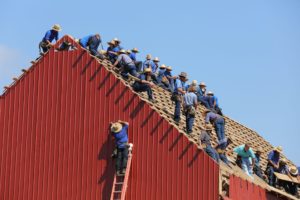
There was a time in American history where neighbors would gather, donate their time, talents, and treasure, and build barns for their neighbors. They were called “Barn Raisings” and were common in the 18th and 19th centuries. If you’ve ever watched the television show “Little House on the Prairie,” then you are already familiar with the concept of barn raising. We need to get back to raising barns as communities… metaphorically speaking.
Barn raising was a necessary part of community life in America when the majority of our population lived on a farm. The impacts of community barn raisings went far beyond providing shelter for livestock.
Barn Raisings Created Relationships
You cannot toil for a week in the sweltering heat with your neighbors building a barn for a week and NOT come away with a few deeper relationships. From the inside jokes that develop to the common goal and even hardships encountered, barn raisings created real relationships within a community. Those relationships played out in very practical ways. Rather than simply shooting random livestock that crosses onto your land, you would go to your neighbor’s house, have a conversation and then help them resolve the matter. This is what living in a relationship-based community helps accomplish.
Barn Raisings Created A Sense of Belonging
When a group of people you may or may not know well come and help you build something as essential and large as a barn, you are left with a sense of belonging to a community. In an agricultural society, having a barn gave you a sense of permanency within the community. It also gave you a sense of obligation in that you would need to help others with their barn raisings. Part of belonging to a community is understanding the role you play and the culture of that community. Barn raisings helped foster a “give first” mentality and culture within a community whereby you always help your neighbor if at all possible many times even if it meant hardship for you. In essence, you learned to take responsibility for the wellbeing of an entire community and not just your own family.
Barn Raisings Created Generational Skillset Development
When seasoned citizens who have been on this earth for a few decades team up with younger generations in order to build something of value, there is a transfer of skillset and knowledge that we lack in modern society. It’s not just the technical skillsets but the wisdom of experience, and pedagogy that are most missing when we lack generational knowledge transfers. Additionally, the elders of a community often find themselves feeling like outsiders because they do not understand or even in some cases know any in the younger generations.
Barn Raisings Created Economic Stability
A barn is the agricultural equivalent of a bank. They give a farmer the ability to set aside assets today that can be used later. They give them the opportunity to shelter something of value (livestock) against the unpredictable (weather). When a community comes together and creates economic stability for the individuals within a community everyone benefits. When every member of a community has the ability to store up wealth, they do not need to steal from others. Barn raisings created economic stability in an agrarian society.
How can we create modern-day barn raisings? By developing repeatable experiences where communities are taught to give first, help others, apply their talent and treasures, and then build together the kinds of companies and intellectual property that create economic stability.
What if every single town and city in America had a regular event where attendees could learn how to be a “give first” community, then learn how to work together to build new things. Once they had grasped these two concepts they could be taught to build new companies and products that generate real value.
This is the kind of barn raising we are missing.
Bring back barn raisings.
